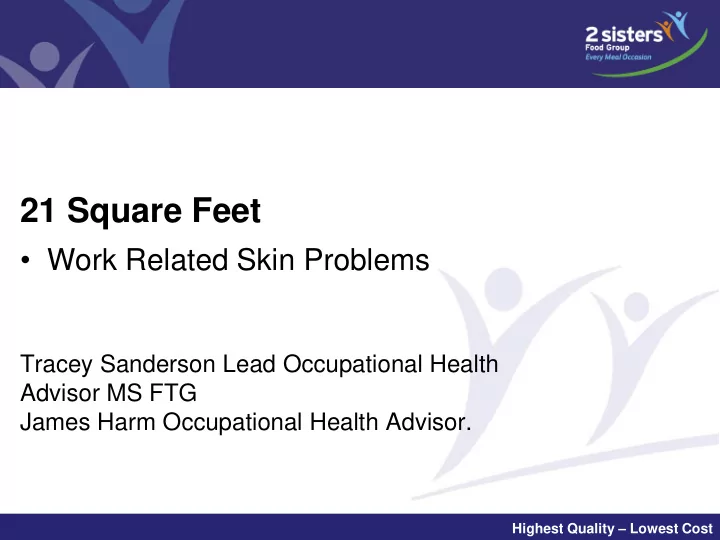

21 Square Feet • Work Related Skin Problems Tracey Sanderson Lead Occupational Health Advisor MS FTG James Harm Occupational Health Advisor. Highest Quality – Lowest Cost
Folding back the layers . Highest Quality – Lowest Cost
The Epidermal Region of the skin Highest Quality – Lowest Cost
At the cellular level Basement Membrane Highest Quality – Lowest Cost
The good, the bad and the ugly Highest Quality – Lowest Cost
Dermatitis What is dermatitis? Dermatitis is a skin condition caused by contact with something that irritates the skin or causes an allergic reaction. It usually occurs where the irritant touches the skin, but not always. Highest Quality – Lowest Cost
Occupational Skin disease . Highest Quality – Lowest Cost
HSE definition • The HSE define occupational skin disease as “ a disease in which workplace exposure to a physical, chemical or biological agent or a mechanical force has been the cause or played a major role in the development of the disease” Highest Quality – Lowest Cost
HSE Statistics • In 2013, there were an estimated 1297 new diagnoses of occupational skin disease by dermatologists reporting to EPIDERM. Of these, 970 (75%) were contact dermatitis, 79 (6%) were other • In 2013, there were 40 cases assessed for disablement benefit Highest Quality – Lowest Cost
Common Work Related Skin Problems • Contact dermatitis • Contact urticarial • Folliculitis and acne • Mechanical Skin Disease • Skin Cancer Highest Quality – Lowest Cost
Substances that harm skin • Common causes of irritant contact dermatitis • Common causes of allergic contact dermatitis • Be aware of: • Check product label or material safety data sheet. • CHIP regulations (Chemical Hazard information and Product supply) – replace by European CLP regulation June 2015 • There are high risk Occupations e.g. hairdressers, printing, metal machining, vehicle repair, dentistry, construction • Harmful substances (list on HSE website and occupations) • Natural Substances e.g. Food – list HSE • Prolonged or frequent contact with Water Highest Quality – Lowest Cost
Our responsibilities • Legal – our responsibility under health and safety law • Moral – our obligation as a good employer • Financial – dealing with skin problems reduces the costs to businesses by reducing sickness absence levels Highest Quality – Lowest Cost
Implications for food industry • Fitness for food handling • Potential food safety What can be passed over? • Staphylococcus aureus • Botulism • Codes Of Practice Highest Quality – Lowest Cost
Managing work to prevent skin problems A P T – Avoid / Protect / Regularly check • Avoid contact with materials that can cause skin problems • Protect the skin • Regularly check for signs of skin problems. Highest Quality – Lowest Cost
Other ways to try to prevent problems Highest Quality – Lowest Cost
Risk Assessments . • Identify people at risk – from jobs and tasks • Describe the hazards and any injury or loss that might arise from it • Investigate any necessary control measures, gloves and protective clothing, hygiene that are currently in place and control measures that are recommended • Decide what health surveillance is appropriate • Provide training Highest Quality – Lowest Cost
Managing work to prevent skin problems • Regularly check effectiveness of controls • Regularly check that gloves and protective clothing are appropriate, and used and stored properly • Check the COSHH assessments are up to date especially when using new products that may harm the skin Highest Quality – Lowest Cost
Summary • What does good skin look like • What affected skin looks like and how it may present • Ensure risk assessments up to date • Avoid / Protect / Regular check • Regularly liaise with your Occupational Health Advisor • Obtain a full history (in case it becomes a RIDDOR) • Physical spot checks • Train and provide as much information as possible Highest Quality – Lowest Cost
Recommend
More recommend